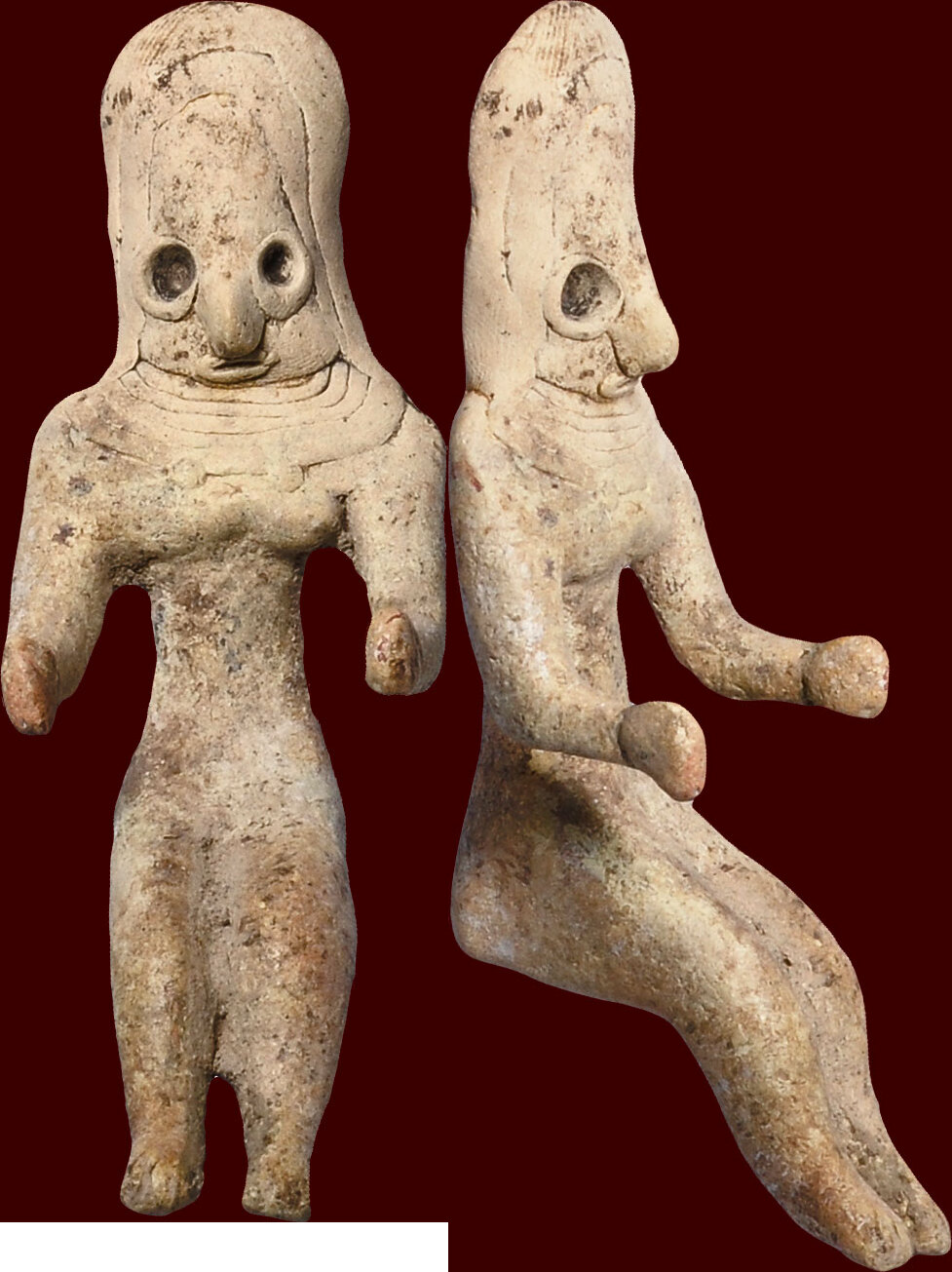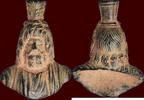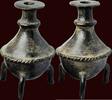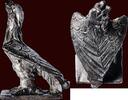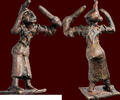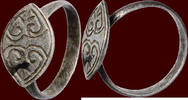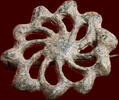NEAR EAST - INDUS VALLEY - BALOCHISTAN - MELUHHA CIVILIZATION - Terracotta fertility idol, circa 3000-2500 BC

zzgl. 18,00 EUR Versand ( nach Deutschland )
| Bestellhotline +49 (0)2871 2180 383 |
| Zahlungsarten |
| Überweisung |
Seated Mother Goddess stylized female idol with mask-like head.
Narrow waist. In a sitting position, arms parallel to body and legs.
Mehrgarh style, terracotta, Balochistan (Pakistan)
provenance : old private collection from France.
Acquired on the art market in the 1970s/1980s.
intact
The name "Balochistan" is generally believed to derive from the name of the Baloch people. Since the Baloch people are not mentioned in pre-Islamic sources, it is likely that the Baloch were known by some other name in their place of origin and that they acquired the name "Baloch" only after arriving in Balochistan sometime in the 10th century. Johan Hansman relates the term "Baloch" to Meluḫḫa, the name by which the Indus Valley Civilisation is believed to have been known to the Sumerians (2900–2350 BC) and Akkadians (2334–2154 BC) in Mesopotamia. Meluḫḫa disappears from the Mesopotamian records at the beginning of the second millennium BC.
Indus Valley Civilization:
The Indus Valley Civilization was rediscovered in 1920-21 when engraved seals were unearthed in the Punjab province of Pakistan at a site called Harappa, a name which is often used to describe the civilization as a whole. Subsequent excavations at Harappa revealed the size and complexity of this ancient city. Other sites were unearthed as well along the banks of the Indus River, including the equally large city of Mohenjodaro. Through archaeological and historical research, we can now say for certain that a highly developed urban civilization flourished in the Indian subcontinent over five thousand years ago. Though the Indus Valley script remains undeciphered, the numerous seals, statuary, and pottery discovered during excavations, not to mention the urban ruins, have enabled scholars to construct a reasonably plausible account of the Indus Valley civilization. Some kind of centralized state, and certainly fairly extensive town planning, is suggested by the layout of the great cities of Harappa and Mohenjodaro. The same kind of burnt brick appears to have been used in the construction of buildings in cities that were several hundred miles apart. The weights and measures also show a very considerable regularity, suggesting that these disparate cities spread out across a vast desert shared a common culture. The Indus Valley people domesticated animals, and harvested various crops, such as cotton, sesame, peas, barley, and cotton. Indus Valley seals have been excavated in far away cities such as Sumer, suggesting that a wealthy merchant class existed, engaged in extensive trading throughout the subcontinent and the Near East. Other than the archaeological ruins of Harappa and Mohenjodaro, these seals provide the most detailed clues about the character of the Indus Valley people. Bulls and elephants appear on these seals, but the horned bull, most scholars agree, should not be taken to be congruent with Nandi, for the horned bull appears in numerous Central Asian figures as well. The women portrayed on the seals are shown with elaborate coiffures, sporting heavy jewelry, suggesting that the Indus Valley people were an urbane people with cultivated tastes and a refined aesthetic sensibility. A few thousand seals have been discovered in Indus Valley cities, showing some 400 pictographs: too few in number for the language to have been ideographic, and too many for the language to have been phonetic.
Considering the size of this civilization, it is puzzling that no monumental art remains, glorifying the names of the powerful rulers or wealthy merchants who could have afforded to construct such memorials. Instead, we find an emphasis on small, elegant art and sophisticated craft technology. Three- dimensional representations of living beings in the Harappan world are confined to, with a few exceptions, small terracotta figurings. Ranging in size from a few inches to a foot in height, the anthropomorphic and animal terracotta figurines from Harappa and other Indus Civilization sites offer a rich reflection of Harappan life in the Bronze Age. Traditionally, the terracotta figurines have been described as toys. Other objects such as carts, wheels, and cots discovered alongside the figurines has only reinforced this notion. However, whether these figures were idols meant to be worshipped or merely charming representations of daily life meant to entertain children remains debatable.
Indus Valley terracotta human figurines:
Anthropomorphic and male and female human forms have been excavated from several sites associated with the Indus Valley Civilization. These are subset of the various figurines that were made of fired clay or terracotta that contained sand, shell fragments, mica particles, and vegetable material. Despite variations in size, most are similar in size to the Indus Valley terracotta animal figurines and range from approximately 6 centimeters up to 30 centimeters, they have overarching similarities in compositional characteristics with specific differentiators based on their period and region of origin.
Evidence suggests that some early Indus figurines (excavated mostly from the Mehrgarh and Nausharo sites), date as far back as c. 7000 BC, prior to the Early Harrapan Phase. The large hoard of figurines excavated from the Harappa and Mohenjo-daro sites in Pakistan suggest that their production reached a peak during the Mature Harappan Phase of the Civilization. The diversity in the compositional aspects of the figurines from both phases also alludes to possible trade and movement of people between present-day India and Iran.
Although there is an overarching compositional continuity between these depictions and those from earlier periods, the newer figurines exhibit much greater diversity and distinctiveness in terms of their subject matter and style. Those from the Early Harappan Phase and earlier commonly featured seated females with wide hips, conical or disc-shaped breasts, joined feet and simple, unarticulated faces (such as the figure above). Leading up to the Mature Harappan Phase, however, there was a transition from seated to standing postures, with generic anthropomorphic and male figurines featuring more prominently,though less so than female figurines.
Scholars have classified the female figurines from the mature phase into two broad categories: the early classic form and the later, figure-eight form. The early classic figures typically feature flat bodies adorned with attached ear ornaments and neck ornaments, such as chokers and necklaces, embellished with beads or pendants. The figure-eight forms are more rounded and lack ear ornaments and mouths.
These two categories, although differing in their overall form, bear several common characteristics. The standing females are usually depicted holding an infant or with their elbows arched outwards and their hands on their hips. Also typifying this group of figurines are conical breasts and mostly uncovered torsos that are girded at the hips with a decorative belt and a short skirt-like piece of clothing that covers the genitalia. The most notable features, however, are the elaborate hairstyles and the distinctive fan-shaped headdresses, which has been of particular interest to scholars. In contrast to most hairstyles and headwear that were typically devoid of decoration, the fan-shaped headdresses, the real-life equivalents of which were thought to have been fashioned out of textiles or even hair, were multiform due to the application of various decorations like cones, flowers, ropes, tiaras, panniers and double-voluted ornaments.
These figurines were hand modeled, likely using three techniques: pinching, used to create sharper ridges for facial features appliqué, used to attach clay shapes, for eyes, eyebrows, lips, breasts and jewelry, to the main figure and incision, used to produce designs and patterns by carving into wet clay. Interestingly, the figurines typically had flattened backs and uneven feet, possibly an intentional feature, which rendered them unable to stand unsupported and allowed only frontal viewing.
Differing interpretations of this group of terracotta objects, particularly the female figurines, offer different attributions. Some scholars propose a cultural or ceremonial significance and others cite religious symbolisms, some claiming the figurines to be representations of a Mother Goddess cult. As with so many other cultural artifacts uncovered from the Indus Valley sites, the purpose and meaning of the terracotta human figurines remains a mystery, in large part due to the fact that the Indus script has not yet been fully deciphered.
Figurines of women are perhaps the most plentiful of the figurines in the Indus Valley. The reason for this is unknown, but some researchers have proposed that women were particularly revered in that society, perhaps relating to their roles as mothers. Studies of burial sites at Mohenjo-Daro and Harappa have shown that a man was often buried with his wife′s family. The female figurines are easily distinguished by a curving, pear-shaped body with large protruding breasts. The effect of these female figurines is two-fold: it emphasizes the beauty, and sexual nature of the female but at the same time, cherishes the nurturing, motherly nature of the female. The figurines of the women tend to also be heavily ornamented.
Bitte beachten Sie unsere Mindestabnahme von 20 Euro. Sendungen nach China sind auf Gefahr des Käufers und nur Zahlung per banküberweisung. An PayPal und Kreditkarte Zahlungen sind immer Verwaltungs- und Risikokosten verbunden. Sendungen nach Russland, Ukraine und israel sind nicht möglich. Der Versand erfolgt innerhalb von 5 Tagen nach Zahlungseingang. BITTE KEIN PAYPAL ODER KREDITKARTE ZAHLUNGEN FÜR EU. Zahlen Sie bitte immer nur mit IBAN; schnell, billig und zuverlässich.
| Versandkosten | ||||
|---|---|---|---|---|
| bis 100,00 EUR | 100,00 EUR bis 500,00 EUR | 500,00 EUR bis 1000,00 EUR | über 1000,00 EUR | |
| Argentinien | 32,00 EUR | 32,00 EUR | 40,00 EUR | 40,00 EUR |
| Australien | 35,00 EUR | 35,00 EUR | 40,00 EUR | 40,00 EUR |
| Belgien | 9,50 EUR | 11,00 EUR | 13,00 EUR | 18,00 EUR |
| Brasilien | 55,00 EUR | 55,00 EUR | 55,00 EUR | 55,00 EUR |
| Bulgarien | 14,00 EUR | 16,00 EUR | 35,00 EUR | 45,00 EUR |
| Chile | 50,00 EUR | 50,00 EUR | 50,00 EUR | 50,00 EUR |
| China | 40,00 EUR | 40,00 EUR | 50,00 EUR | 50,00 EUR |
| Dänemark | 11,50 EUR | 13,00 EUR | 16,00 EUR | 20,00 EUR |
| Deutschland | 9,50 EUR | 11,00 EUR | 13,00 EUR | 18,00 EUR |
| Estland | 13,00 EUR | 14,00 EUR | 15,00 EUR | 25,00 EUR |
| Frankreich | 9,50 EUR | 11,00 EUR | 16,00 EUR | 25,00 EUR |
| Griechenland | 15,00 EUR | 25,00 EUR | 30,00 EUR | 35,00 EUR |
| Großbritannien | 25,00 EUR | 25,00 EUR | 26,00 EUR | 28,00 EUR |
| Hong Kong | 40,00 EUR | 40,00 EUR | 50,00 EUR | 50,00 EUR |
| Indien | 35,00 EUR | 35,00 EUR | 40,00 EUR | 50,00 EUR |
| Indonesien | 35,00 EUR | 35,00 EUR | 40,00 EUR | 40,00 EUR |
| Israel | 200,00 EUR | 200,00 EUR | 200,00 EUR | 200,00 EUR |
| Japan | 40,00 EUR | 40,00 EUR | 40,00 EUR | 40,00 EUR |
| Kambodscha | 65,00 EUR | 65,00 EUR | 65,00 EUR | 65,00 EUR |
| Kanada | 30,00 EUR | 30,00 EUR | 35,00 EUR | 35,00 EUR |
| Liechtenstein | 20,00 EUR | 20,00 EUR | 25,00 EUR | 25,00 EUR |
| Luxemburg | 11,00 EUR | 13,00 EUR | 16,00 EUR | 25,00 EUR |
| Malaysia | 35,00 EUR | 35,00 EUR | 40,00 EUR | 45,00 EUR |
| Niederlande | 8,50 EUR | 8,50 EUR | 11,00 EUR | 14,00 EUR |
| Norwegen | 25,00 EUR | 25,00 EUR | 30,00 EUR | 35,00 EUR |
| Österreich | 11,50 EUR | 12,50 EUR | 15,00 EUR | 25,00 EUR |
| Polen | 13,00 EUR | 14,00 EUR | 16,50 EUR | 25,00 EUR |
| Portugal | 13,00 EUR | 14,00 EUR | 18,00 EUR | 25,00 EUR |
| Rumänien | 16,00 EUR | 18,00 EUR | 25,00 EUR | 35,00 EUR |
| Russische Föderation | 200,00 EUR | 200,00 EUR | 200,00 EUR | 200,00 EUR |
| Schweiz | 30,00 EUR | 30,00 EUR | 40,00 EUR | 40,00 EUR |
| Serbien | 25,00 EUR | 25,00 EUR | 30,00 EUR | 35,00 EUR |
| Singapur | 35,00 EUR | 35,00 EUR | 35,00 EUR | 40,00 EUR |
| Slowakei | 13,00 EUR | 15,00 EUR | 20,00 EUR | 25,00 EUR |
| Spanien | 11,50 EUR | 13,50 EUR | 16,50 EUR | 25,00 EUR |
| Sri Lanka | 35,00 EUR | 35,00 EUR | 40,00 EUR | 45,00 EUR |
| Tschechische Republik | 12,00 EUR | 14,00 EUR | 18,00 EUR | 25,00 EUR |
| Ukraine | 200,00 EUR | 200,00 EUR | 200,00 EUR | 200,00 EUR |
| Ungarn | 14,00 EUR | 16,00 EUR | 25,00 EUR | 30,00 EUR |
| Vereinigte Staaten von Amerika | 32,00 EUR | 32,00 EUR | 35,00 EUR | 40,00 EUR |
| Europäische Union | 15,00 EUR | 17,00 EUR | 25,00 EUR | 30,00 EUR |
| Welt | 40,00 EUR | 40,00 EUR | 50,00 EUR | 50,00 EUR |
Ein über die MA-Shops abgesicherter Kauf findet niemals außerhalb von MA-Shops statt.
Bestellen Sie sicher online mit dem MA-Shops Warenkorb.
Vielen Dank.
|
Verkäufer-Startseite | 0Warenkorb | AGB | Impressum | MA AGB | Datenschutzerklärung | Garantie | MA-Shops Neuzugänge Copyright ® 2001-2025, MA-SHOPS Muenzen All Rights Reserved. Designated trademarks and brands are the property of their respective owners. |
 Münzen beim Fachhändler kaufen
Münzen beim Fachhändler kaufen


